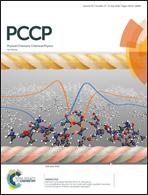Aggregation and fragmentation in liquids with dispersed nanoparticles
Abstract
Nanoparticle-induced aggregation and fragmentation phenomena in liquid media are investigated by applying a model of preferential attachment of dispersing molecules to randomly chosen nanoparticles and larger particles, each containing a single nanoparticle. The model is based on the assumption that immersed nanoparticles, media molecules, and the resulting composite particles do not form any self-linked structures, i.e., that they do not undergo homoaggregation as a consequence of, e.g., electrostatic repulsion. Probabilities of both connecting and disconnecting a molecule are considered as being proportional to the surface area of a target particle. Additionally, the aggregation probability is assumed to be driven by van der Waals interactions. The interplay between aggregation and fragmentation processes is studied for different relative efficiencies (frequencies) of these processes. In particular, the time evolution of the particle size distribution is analyzed at various values of the relative frequency rate between aggregation and fragmentation events. It is shown that the evolution of an ensemble of particles over relatively long time periods can lead to very peculiar particle size distributions, including nearly homogeneous and highly heterogeneous partitioning. This indicates that, by controlling the frequency rate, one can obtain materials with very diverse and unique properties. Theoretical results obtained within the studied model are compared with corresponding experimental data.



 Please wait while we load your content...
Please wait while we load your content...